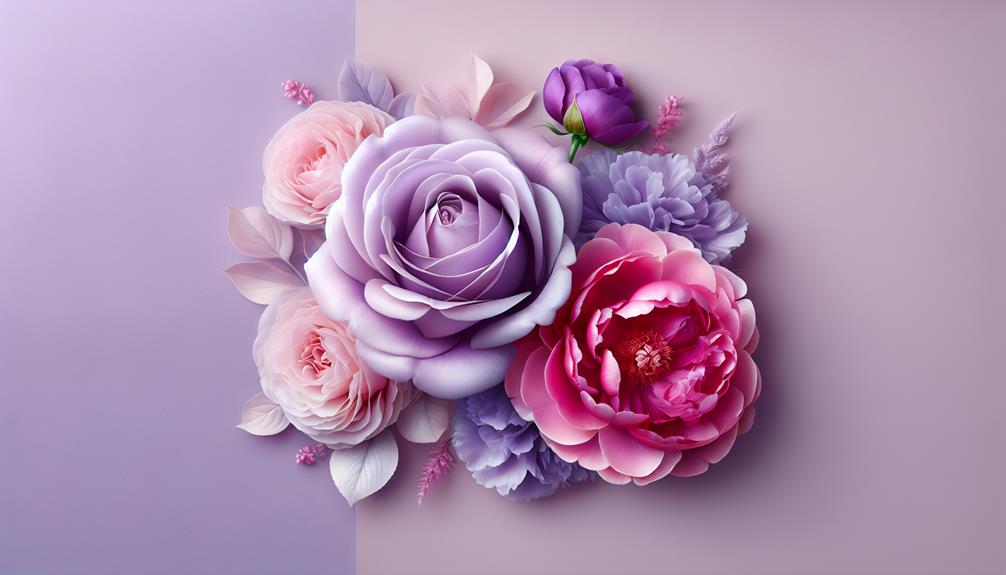When it comes to color combinations, the debate on whether purple and pink match has sparked countless discussions. Some say they clash like oil and water, while others swear by their surprising compatibility.
But before you dismiss this pairing entirely, let's take a closer look at the intricacies of color theory and the psychological impact of these hues. Understanding the nuances of purple and pink can shed light on how they can either clash or harmonize in various contexts.
So, are you ready to uncover the truth behind this colorful conundrum?
Table of Contents
Key Takeaways
- Purple and pink create a harmonious balance with their complementary meanings and emotional impact.
- Understanding color psychology reveals that purple and pink blend well to evoke various emotions.
- Cultural associations support the pairing of purple and pink due to their rich symbolism and significance.
- Mixing purple and pink is a trendy choice that adds a modern and stylish touch to any design or space.
Color Theory Basics
Understanding color theory is essential for anyone looking to create visually appealing designs. When it comes to color psychology, different colors evoke various emotional responses. For example, red is often associated with passion and energy, while blue tends to convey calmness and trust. By understanding these emotional connections, designers can strategically choose colors to elicit specific reactions from their audience.
The history of color symbolism is rich and diverse, with colors holding significant meanings in different cultures and time periods. For instance, in ancient Egypt, the color yellow symbolized eternity and the afterlife, reflecting the importance of the sun god Ra. Similarly, in Chinese culture, the color red is linked to good luck and prosperity. These historical significances of colors can still influence modern design choices and add layers of meaning to visual compositions.
The Meanings of Purple and Pink
When it comes to colors, understanding their symbolism is key. Purple and pink each carry unique meanings that vary across cultures and contexts.
Exploring these associations can provide insights into how to effectively use them in design and aesthetics.
Color Symbolism Breakdown
Exploring the meanings of purple and pink reveals their unique and fascinating symbolism in color psychology. Purple is often associated with creativity, luxury, and spirituality. It symbolizes mystery and magic, making it a popular choice in fashion trends for those seeking a touch of sophistication.
On the other hand, pink exudes feelings of love, compassion, and playfulness. It represents sweetness and innocence, frequently seen in fashion as a symbol of femininity and romance. Understanding the significance of these colors in color psychology can help individuals make intentional choices when incorporating them into their wardrobe or surroundings.
Whether it's embracing the regal allure of purple or the charming allure of pink, these colors hold deeper meanings that go beyond mere aesthetics.
Cultural Associations Explored
Delving into the cultural associations of purple and pink reveals a rich tapestry of symbolism and significance. Purple has long been associated with royalty, luxury, and spirituality across various cultures. In fashion trends, purple is often used to convey elegance and creativity.
On the other hand, pink is commonly linked to femininity, love, and tenderness. In recent years, pink has also been breaking gender norms, with more men embracing this color in clothing and accessories.
Understanding the cultural significance of these colors can help individuals make intentional choices in their wardrobe or design preferences. Whether it's the regal allure of purple or the soft charm of pink, both colors play a significant role in shaping our perceptions and expressing personal style.
Complementary Color Schemes
As we consider the meanings of purple and pink, it becomes clear that they hold significant importance in creating complementary color schemes. When exploring the world of color coordination, purple and pink stand out as a dynamic duo that can elevate any design or outfit. Here are four key points to keep in mind when incorporating these hues into your fashion choices:
- Purple symbolizes luxury and creativity, adding a touch of sophistication to your ensemble.
- Pink conveys playfulness and romance, injecting a sense of charm and sweetness into your look.
- Combining purple and pink creates a harmonious balance between boldness and softness.
- Embracing these colors in your wardrobe can help you stay on-trend with the latest fashion color palettes.
Contrast Vs. Harmony
When it comes to pairing purple and pink, the key lies in understanding the balance between contrast and harmony.
The color wheel basics can guide us to create visually striking combinations or soothing blends.
Color Wheel Basics
Understanding the color wheel basics involves grasping the concept of contrast versus harmony in color combinations. When it comes to color psychology and coordination, mastering the color wheel is essential. Here are four key points to keep in mind:
- Contrast: Pairing colors that are opposite each other on the color wheel creates a dynamic and eye-catching look.
- Harmony: Colors that are adjacent on the color wheel create a sense of cohesion and balance in the overall design.
- Analogous Colors: These are colors that sit next to each other on the color wheel and often work well together to create a harmonious palette.
- Complementary Colors: Colors that are directly across from each other on the color wheel provide a high level of contrast and vibrancy in a color scheme.
Visual Impact
Exploring the impact of visual contrast versus harmony in color combinations is key to creating dynamic and cohesive designs. When considering color psychology and perception, contrasting colors like purple and pink can evoke strong emotional responses due to the stark differences in their wavelengths.
This contrast can create a bold and vibrant aesthetic, making the colors pop and stand out. On the other hand, harmonious color combinations can offer a sense of unity and balance, appealing to a more soothing and calming emotional impact. Understanding how colors interact and influence each other is vital in achieving the desired aesthetics in design.
Styling Tips
In styling color combinations, balancing contrast and harmony is key to creating visually appealing designs that capture attention effectively. When it comes to color coordination, understanding the dynamics between contrasting and harmonious colors can elevate your style game. Here are some tips to help you master the art of color pairing:
- Contrast with a Pop: Pairing purple with a pop of pink can create a striking contrast that adds a bold touch to your outfit.
- Monochromatic Elegance: Opt for different shades of purple and pink for a trendy monochromatic look that exudes elegance.
- Accessorize Wisely: Use accessories like scarves or jewelry to experiment with different color combinations without overwhelming your outfit.
- Mix Textures: Combining textures in purple and pink fabrics can enhance the overall look and feel of your ensemble.
Pairing Purple and Pink in Fashion
When I pair purple and pink in my outfits, they create a vibrant and stylish combination that never fails to make a statement. These trendy combinations defy traditional fashion rules, blending two bold colors into eye-catching ensembles. Purple and pink, when paired together, offer a dynamic mix that can elevate any look.
To pull off this daring duo, I often opt for a pink blouse paired with purple trousers or a purple skirt with a pink top. Accessorizing with gold or silver jewelry adds a touch of elegance to the ensemble. When experimenting with purple and pink, it's essential to balance the color palettes to avoid overwhelming the outfit.
Incorporating these hues into my wardrobe has allowed me to step out of my comfort zone and embrace a more playful and fashion-forward style. Whether it's a casual day out or a special event, the purple and pink combination never fails to turn heads and receive compliments.
Purple and Pink in Home Decor
Incorporating touches of purple and pink into home decor can bring a fresh and vibrant energy to any living space. These colors, often associated with creativity and sensitivity, can create a harmonious and inviting atmosphere in your home.
Here are some key points to take into account when adding purple and pink to your decor:
- Color Psychology: Purple is linked to luxury, wisdom, and spirituality, while pink evokes feelings of love, warmth, and tranquility. Combining these hues can create a balanced environment that promotes relaxation and creativity.
- Emotional Impact: Purple and pink hues can influence mood and emotions. Purple can encourage introspection and mindfulness, while pink can create a sense of calm and nurturing in a room.
- Trends: Mixing purple and pink in home decor is a popular trend that adds a modern and stylish touch to any space. From accent pillows to wall art, these colors can be taken into consideration in various ways.
- Popular Combinations: Pairing purple and pink with neutrals like white, gray, or beige can help balance the vibrancy of these colors and create a chic and sophisticated look in your home.
Tips for Balancing the Colors
To achieve a harmonious blend of purple and pink in your home decor, consider the following tips for balancing the colors effectively. Color coordination is key when working with these vibrant hues.
One approach is to use a 60-30-10 ratio for the dominant, secondary, and accent colors respectively. For instance, you could paint your walls a soft lavender (60%), incorporate pink chairs or cushions (30%), and add pops of brighter pink in accessories like vases or artwork (10%). This creates a cohesive look without overwhelming the space with one color.
Design balance is equally important. If you have a large pink sofa, balance it out with smaller purple decorative items like throw pillows or a rug. Conversely, if you have a bold purple statement wall, complement it with softer pink elements like curtains or a lampshade.
Cultural Perspectives on Color
Exploring the way different cultures perceive and interpret colors adds a fascinating layer to the discussion of decor choices like purple and pink. Cultural perceptions heavily influence how colors are viewed and utilized in various societies. Here are four intriguing points that shed light on the significance of cultural perspectives and color psychology:
- Symbolism: Colors can carry deep cultural meanings. For example, while white symbolizes purity in Western cultures, it represents mourning in some Eastern cultures.
- Associations: Different colors evoke distinct emotions and associations across cultures. Red, for instance, may symbolize luck in one culture and danger in another.
- Historical Influences: Historical events and traditions shape how colors are perceived. The use of certain colors in rituals or ceremonies can impact their cultural significance.
- Geographical Variances: Colors can hold different meanings based on geographical location. For instance, green may represent nature and growth in one culture but jealousy in another.
Understanding cultural perceptions and color psychology provides valuable insights into the diverse ways colors can be interpreted and integrated into design choices.
The Role of Personal Preference
Considering personal preferences plays an important role in determining one's color choices for decor and design. When it comes to selecting colors like purple and pink, personal preferences can vary widely. Some individuals may gravitate towards the bold and regal vibes of purple, while others might prefer the soft and feminine tones of pink. These preferences are often influenced by our unique experiences, memories, and associations with certain colors.
Color psychology also comes into play when discussing personal preferences. Purple is often associated with luxury, creativity, and spirituality, while pink is linked to love, compassion, and playfulness. Understanding how these colors make us feel can heavily impact our choices in decor and design. For instance, someone who values relaxation and tranquility may opt for soft lavender hues, while a person who seeks energy and excitement might lean towards vibrant magenta shades.
In the end, personal preferences are key in creating spaces that resonate with us on a deeper level. By listening to our color inclinations and considering the emotional responses they evoke, we can curate environments that truly reflect our personalities and nurture our well-being.
Final Verdict: Do They Match?
In my opinion, the combination of purple and pink can indeed match beautifully when used thoughtfully in decor and design. When considering color psychology, purple represents luxury, creativity, and spirituality, while pink evokes feelings of playfulness, love, and warmth. These contrasting yet complementary emotions can create a dynamic and balanced atmosphere when used together.
Fashion trends have also played a role in solidifying the compatibility of purple and pink. Designers often pair these colors on runways, showcasing how they can harmonize in clothing and accessories. This trend has influenced interior design choices, with many homeowners incorporating purple and pink accents into their living spaces.
The key to successfully merging purple and pink lies in the balance and proportion of each color used. Whether it's through furniture, textiles, or wall paint, a thoughtful approach to incorporating these hues can result in a visually striking and cohesive look that pleases the eye.
Frequently Asked Questions
Can Purple and Pink Be Used Together in a Professional Setting, Such as in a Corporate Office?
In a professional setting like a corporate office, purple and pink can be used together to create a sophisticated and modern look. When paired strategically, these colors can convey creativity, confidence, and a touch of femininity.
Are There Any Specific Color Combinations That Should Be Avoided When Pairing Purple and Pink?
When pairing purple and pink, consider fashion trends, color psychology, makeup looks, and floral arrangements. Necessary to avoid clashing shades that may overwhelm the eye. Harmonizing these hues can create a visually appealing and stylish combination.
How Do Different Lighting Conditions Affect the Way Purple and Pink Colors Appear When Paired Together?
In color psychology, lighting plays an essential role in how purple and pink blend. Various lighting effects alter visual perception, impacting color harmony. Understanding how different lights influence these hues when paired together enhances mastery of color combinations.
Are There Any Historical or Cultural Associations With Purple and Pink That Should Be Considered When Using Them Together?
Considering historical symbolism and cultural significance, purple and pink have played diverse roles in different societies. Their presence in fashion trends and artistic expressions has evolved over time, reflecting changing societal values and aesthetics.
Are There Any Specific Textures or Patterns That Work Well With a Purple and Pink Color Scheme in Interior Design?
Textural contrast can enhance a purple and pink color scheme in interior design. Pairing plush fabrics with sleek surfaces creates a dynamic balance. Coordinating patterns like florals and geometric shapes can evoke a sense of design harmony.
- Fabric Yardage for Pillow Cases: A Complete Chart for All Bed Sizes - June 25, 2025
- How Much Fabric for a King Size Pillow Case? A Simple Calculation - June 25, 2025
- Choosing the Right Fabric for Sewing Pillow Case Dresses - June 25, 2025







